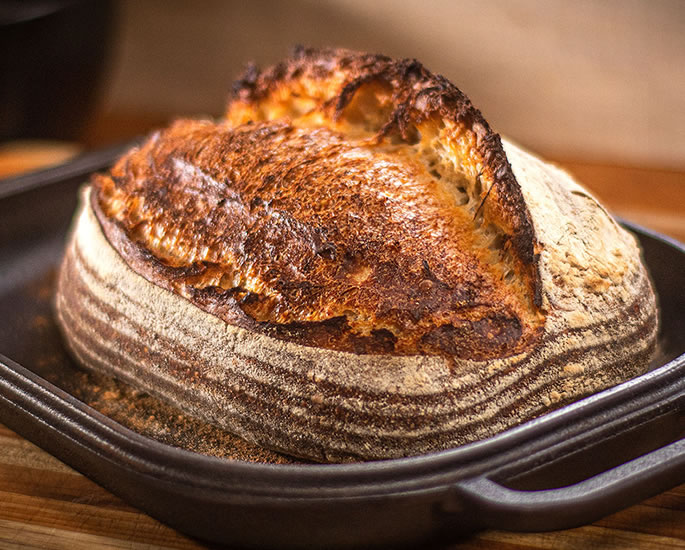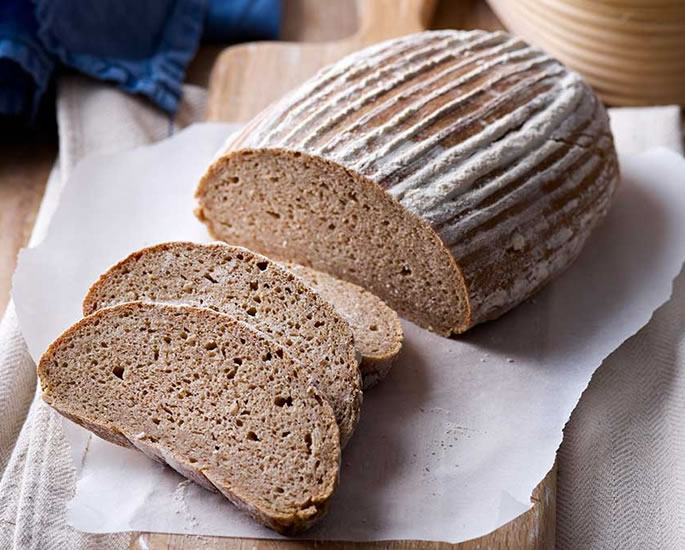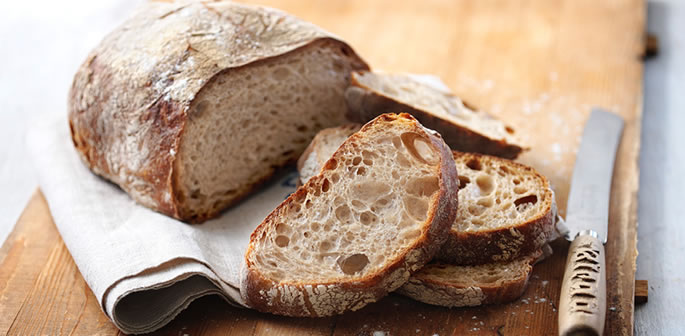It is rich in vitamins B1, B6 and B12
Sourdough bread has several health benefits that might make it better for you than conventional bread.
Sourdough bread is a type of bread made using a natural yeast starter that is created by fermenting flour and water over several days.
Unlike commercial yeast, which is a single strain of yeast that is added to the dough, a sourdough starter is a mixture of wild yeasts and lactobacilli that are naturally present in the environment.
To make sourdough bread, a portion of the starter is added to the dough mixture along with flour, water and salt. The dough is then left to rise for several hours or overnight. During this time, the wild yeasts and bacteria in the starter help to ferment and leaven the dough.
Sourdough bread has a distinct tangy flavour and chewy texture that sets it apart from other types of bread.
It also has a longer shelf life than bread made with commercial yeast, thanks to the natural preservatives produced during the fermentation process.
It has gained popularity in recent years due to its unique flavour and health benefits.
We look at how these benefits might make sourdough bread arguably a better option to eat than conventional bread.
More Nutritious than Regular Bread

Although sourdough bread is typically made from the same flour as other types of bread, the fermentation process improves its nutrition profile.
It is rich in vitamins B1, B6 and B12, as well as minerals like iron, zinc and selenium.
Whole grain bread contains a good amount of minerals, including potassium, phosphate, magnesium and zinc.
But your body’s ability to absorb these minerals is limited by the presence of phytic acid (phytate).
Phytic is naturally found in several plant-based foods, including grains. It is often referred to as an antinutrient because it binds to minerals, making them more difficult for your body to absorb.
The lactic acid bacteria found in sourdough bread lower its pH, which helps deactivate phytate.
According to research, sourdough fermentation could reduce the phytate content of bread by more than 70%.
The dough’s low pH, combined with lactic acid bacteria, tends to increase the nutrient and antioxidant content of sourdough bread.
Easier Digestion

Usually, sourdough bread is easier to digest than regular bread.
This is because the lactic acid bacteria and wild yeast help neutralise the antinutrients naturally found in grains. This helps the body digest foods made from these grains more easily.
Sourdough fermentation may also produce prebiotics, which is an indigestible fibre that feeds the beneficial gut bacteria.
This eases digestion and improves your gut health.
The sourdough fermentation also helps break down large compounds found in grains, making them easier for your body to digest.
Gluten is found in certain grains and can cause digestive issues in people who are allergic to it.
The lower gluten content in sourdough bread may make it easier to tolerate.
This makes gluten-free sourdough bread an interesting option for people with gluten-related disorders.
But it is important to note that sourdough fermentation does not degrade gluten completely. Those with coeliac disease should avoid sourdough bread containing wheat, barley or rye.
Better Blood Sugar Control

Compared to other types of bread, sourdough bread may be better for blood sugar control.
According to researchers, sourdough fermentation may change the structure of carb molecules.
This reduces the bread’s glycemic index (GI) and slows down the speed at which sugars enter the bloodstream.
But there are different factors which can affect the GI response. Due to this, more research is needed on how sourdough affects it.
The glycemic index measures how a food affects blood sugar.
Foods with a lower GI are less likely to cause a spike in blood sugar levels.
In addition, the lactic acid bacteria found in the dough produce acids during fermentation. Some researchers believe these acids may help prevent a spike in blood sugar.
The fermentation process is often used to make rye bread. This is because rye does not contain enough gluten for baker’s yeast to work effectively.
In one study, participants who consumed rye bread had a lower spike in insulin levels than those who ate the same amount of regular wheat bread.
Several other studies compared participants’ blood sugar increases after eating sourdough bread and bread fermented with baker’s yeast.
In general, participants who consumed sourdough bread had lower blood sugar and insulin levels than those who ate bread fermented with baker’s yeast.
Sourdough Bread Recipe

Making sourdough bread is fairly easy but it can be time-consuming due to the fermentation process.
Nevertheless, the result will be worth the effort.
Ingredients
- 500g strong white flour, plus extra for dusting
- 1 tsp salt
- 1 tbsp clear honey
- Flavourless oil, for greasing
For the Starter
- 700g strong white flour
Method
- To make the starter, mix 100g of flour with 125 ml of slightly warm water in a large bowl. Whisk until smooth and lump-free.
- Transfer to a large jar and leave the lid ajar for around one hour in a warm place (around 25°C), then seal and set aside.
- Each day for the next six days, tip away half of the original starter, and add an extra 100g of flour and 125 ml of slightly warm water. Over time, the starter will become bubbly and smell quite sweet. On the seventh day, it should be ready to use.
- In a bowl, add flour, 225ml warm water, 300g of the starter, salt and honey. Stir until combined.
- Transfer the dough to a lightly floured surface. Knead for 10 minutes until soft and elastic.
- Place the dough into a large, well-oiled bowl and cover. Leave in a warm place to rise for three hours.
- Line a bowl with a clean tea towel and flour it well.
- Tip the dough onto the work surface and knead briefly to remove any air bubbles. Shape into a smooth ball and dust with flour.
- Place the dough, seam-side up, in the bowl. Cover loosely and leave at room temperature until roughly doubled in size.
- Preheat the oven to 210°C and place a large baking tray into it. Fill a small roasting tin with some water and place it at the bottom of the oven to generate steam.
- Remove the baking tray, sprinkle with flour then carefully tip the dough onto the tray.
- Make a few slits in the dough with a knife then bake for 35-40 minutes or until golden brown and sounds hollow when tapped on the bottom.
- Leave to cool on a wire rack for 20 minutes before slicing.
This recipe was inspired by BBC Good Food.
It is important to note that this recipe can be adapted by adding additional ingredients such as herbs, seeds or dried fruits to the dough before baking.
Due to its fermentation process, sourdough bread develops several benefits.
One of them is a longer shelf life but more importantly, its nutrition profile is improved.
This, as well as other benefits, make it an option to consider when you want to improve your health.
With the addition of it being fairly easy to make, sourdough bread might be better for you than conventional bread.






























































